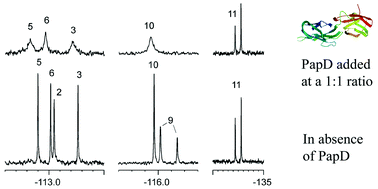Use of 19F NMR spectroscopy to screen chemical libraries for ligands that bind to proteins
Abstract
Identification of compounds from chemical libraries that bind to

* Corresponding authors
a
Organic Chemistry, Department of Chemistry, Umeå University, SE-901 87 Umeå, Sweden
E-mail:
jan.kihlberg@chem.umu.se
b Orbichem AB, Ole Römers Väg 12, SE-223 70 Lund, Sweden
c AstraZeneca R&D Mölndal, SE-431 83 Mölndal, Sweden
Identification of compounds from chemical libraries that bind to

 Please wait while we load your content...
Something went wrong. Try again?
Please wait while we load your content...
Something went wrong. Try again?
T. Tengel, T. Fex, H. Emtenäs, F. Almqvist, I. Sethson and J. Kihlberg, Org. Biomol. Chem., 2004, 2, 725 DOI: 10.1039/B313166A
To request permission to reproduce material from this article, please go to the Copyright Clearance Center request page.
If you are an author contributing to an RSC publication, you do not need to request permission provided correct acknowledgement is given.
If you are the author of this article, you do not need to request permission to reproduce figures and diagrams provided correct acknowledgement is given. If you want to reproduce the whole article in a third-party publication (excluding your thesis/dissertation for which permission is not required) please go to the Copyright Clearance Center request page.
Read more about how to correctly acknowledge RSC content.
 Fetching data from CrossRef.
Fetching data from CrossRef.
This may take some time to load.
Loading related content
